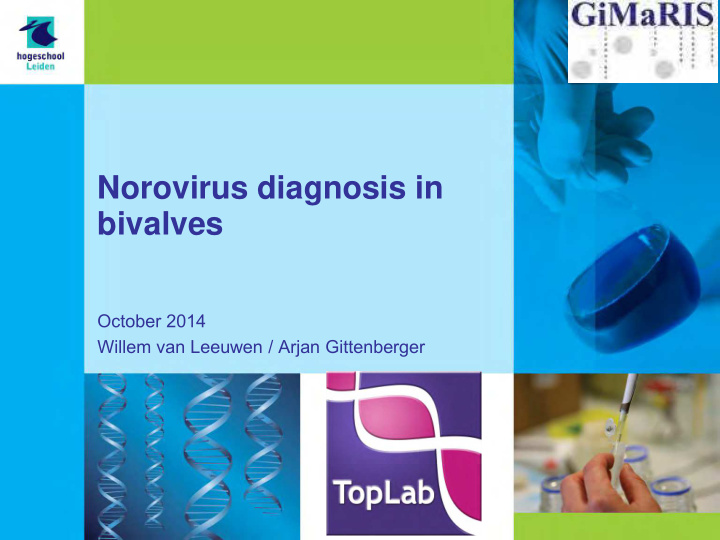



Norovirus diagnosis in bivalves October 2014 Willem van Leeuwen / Arjan Gittenberger
Norovirus some background – Infects human worldwide (all ages) – 50% of cases with gastro-enteritis (non-bloody diarrhea, abdominal cramps, vomiting) – Duration of disease: 12-60h; Incubation 15-48h – Transmission - only from human source: • Fecal-oral route: fecal contaminated food • Outbreak-related, highly infectious (minimal dose: approx 10 active virus particles) sensitive diagnostics
Norovirus some background – Epidemiology: • 5 Genogroups: most predominant Genogroup I and II (rarely IV) are human-related specific diagnostics
Norovirus diagnostics Challenges for diagnostics: – Sampling (info is limited, distribution of Norovirus within bivalves is unknown) – Cannot be cultured: molecular approaches – identification of genetic material (RNA), not active virusparticles!! Interpretation of results is challenging; a clinical validation is needed. – Specific for Genogroup I and II, human only? – Choosen method may also detect NoroV from animal origin. Primers and probes are developed for Norovirus identification in patients (hospital environment). Unknown in literature that Norovirus PCR may detect G2 from pig, cattle or chicken origin. – Matrix (bivalves)
Norovirus diagnostics our method uses ISO protocols
Norovirus www.gimaris.com/viruscontrol.html • Norovirus via Viruscontrol ; – Result within 24 h (delivered before 9.00h, same day) if reaction quality is confirmed by the controls. – Customer can make quick decisions to sell or not to sell shellfish from a production area. – Positive result: customer can decide within the same day not to sell shellfish for consumption; no risk for human health – In this way: obligatory not to report result to the authorities, as far as we know. – For that reason: we only report to the customer.
Norovirus diagnostics • Norovirus via Viruscontrol ; – Our reaction controls: • Positive control (GI and GII virus particles from patient sample (most realistic*), NOT an artificial plasmid construct with Noro target sequence), spike in prechecked Norovirus negative relevant matrix • Negative control, prechecked Norovirus negative matrix – Internal process control (MS-2 phage spiked in every sample – Non-template control *) many labs use artificial constructs of plasmids with genetic information of the target (more false positivity).
Norovirus diagnostics • qPCR generated by processor with semi-quantitative result: Cq-value • Visual interpretation of the curves in quality (PCR efficiency) • Cq >40 is negative result (if no inhibition), if necessary repeat test. In international literature: LLOD Cq<40. Cq>40 is not accepted (active virus??). Suprisingly, labs do accept • If any of the controls fails: repeat test completely. • External quality control is highest level of control (performance of your lab….in comparison with “the rest”), provided European Union Reference Lab (CEFAS)
Norovirus diagnostics To our opinion: qPCR result is always semi-quantitative. No real reference series with active virus particles can be made (we can’t culture Noro) for interpolation of the sample. Only with artificial plasmids (not presenting reality) we may be able to quantify the results.
Need for HARMONIZATION Threshold value
We propose: • A threshold value for Norovirus diagnostics • Threshold value as high (Cq value) as feasible • Feasible is Cq around 39-40 for all labs to harmonize the results form the labs. • How to realize??
proposal • To link the results of molecular amplification techniques from different laboratories, standard material from a production lab (verified by 2-3 reference laboratories) is needed. • This standard should be distributed to all participating laboratories. • Labs are using different protocols with or without modifications and in this way • Results from each lab can be harmonized / linked and after clinical validation critical threshold values can be determined
Recommend
More recommend